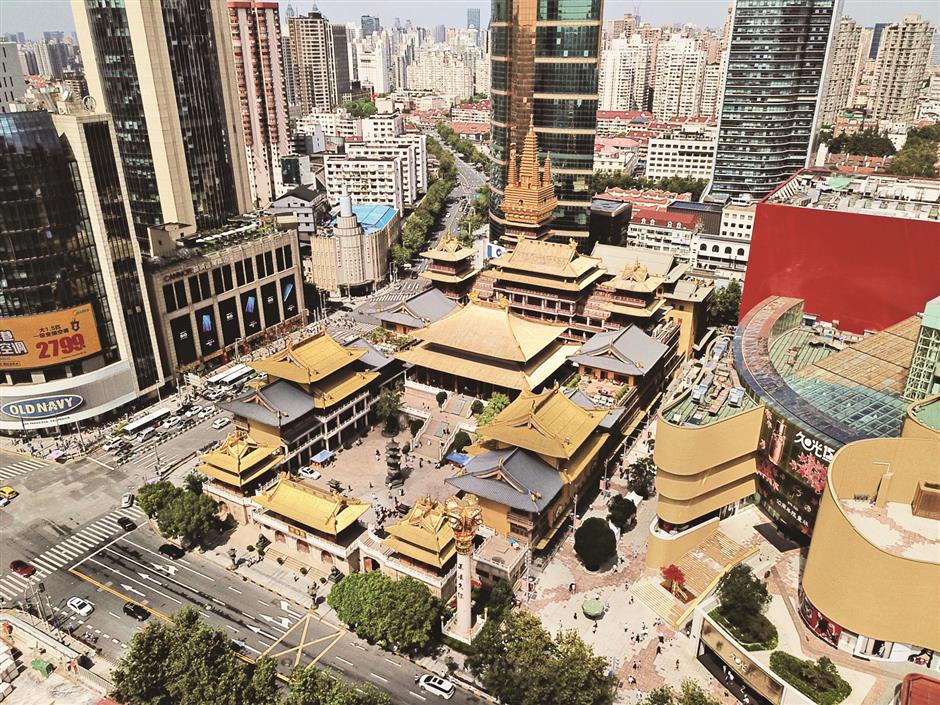政府新闻
静安寺的过往 2024-06-10
Jing’an District, named after the iconic Jing’an Temple, is a high-end commercial hub in Shanghai — home to skyscrapers, luxury malls, five-star hotels and office buildings. The district and the temple are symbols of the city’s rich history and transformation.
About 2,000 years ago, the land Jing’an sits on was formed by silt carried downstream by the Yangtze River and shaped by sea tides.
The temple’s history dates back to the Three Kingdoms period (AD 220-280). Initially, it was built on the northern bank of the Wusong River during the reign of Sun Quan, king of Wu.
After being destroyed by a flood in 1216, the temple was reconstructed at its current location on Nanjing Road W.
The earliest detailed account of the temple appears in a document in the Southern Song Dynasty (1127-1279), which meticulously records the region’s history and geography.
Over the centuries, the temple underwent numerous cycles of destruction and reconstruction.
During the Taiping Rebellion in the mid-19th century, the temple was almost completely destroyed, with only the main hall remaining. The structure was rebuilt in the late Qing Dynasty (1644-1911) and further restored in the 20th century.
After the founding of the People’s Republic of China in 1949, the city designated the temple a cultural heritage site.
The temple suffered significant damage during the “cultural revolution” (1966-76), with the main hall burned to the ground in 1972. Restoration efforts began in the 1980s, and by 1990, the temple had regained much of its former glory.

Today’s Jing’an Temple is surrounded by modern buildings.
From the Song to the Qing Dynasty, the area around the temple was sparsely populated, with farmland and burial grounds intersected by rivers and streams. Local villages were typically named after the families who lived there, such as Zhang, Lu and Yang.
The “Eight Scenes of Jing’an” were celebrated attractions dating back to the Yuan Dynasty (1271-1368). They included the Chiwubei stele, a pair of cypress trees planted during the Chen Dynasty (AD 557-589), a lecture platform used by monks and the famous Bubbling Well.
Over time, most of those relics vanished, leaving only the Bubbling Well, which remains a cherished landmark. Located in front of the temple, this natural spring has been a source of fascination for centuries.
In the late 19th century, the well was filled in during road construction. However, it was “rediscovered” during construction of Shanghai’s Metro Line 2 in the late 1990s. In 2001, the well was restored as part of a temple renovation, allowing visitors to once again appreciate this historical feature.
The temple was not always a quiet sanctuary. Its annual temple fair, which dates back to the Qing Dynasty, was a boisterous event that attracted crowds from far and wide. Farmers, craftsmen and merchants sold their goods at the fair, which was held during the Bathing the Buddha Festival on the eighth day of the fourth lunar month.
By the early 20th century, the temple fair had grown into a bustling marketplace with hundreds of stalls.
However, the Japanese invasion of China in the 1930s led to the decline of the temple area. After the war, the fair was briefly revived but finally disappeared in 1963 due to urban development and traffic concerns.
The administrative evolution of the area reflects the deep historical and cultural layers that define this unique part of the city.
In the early 20th century, the area around the temple lay at the intersection of the International Settlement, the French Concession and the Chinese sections.
In 1949, after the People’s Liberation Army took over Shanghai, the district boundaries were defined and administrative divisions were adjusted over the years. In 1960, Jing’an was reinstated as a district in its own right, after having been merged with parts of other districts.
In 2015, Shanghai government decided to consolidate Jing’an and Zhabei districts, administratively dividing the new jurisdiction into 13 subdistricts and one town. Today, Jing’an is home to about 1 million people.
Despite dramatic economic progress and an ultra-modern environment, Jing’an Temple remains the soul of the district.
Source: Shanghai Daily
